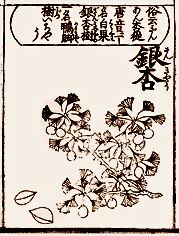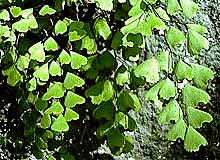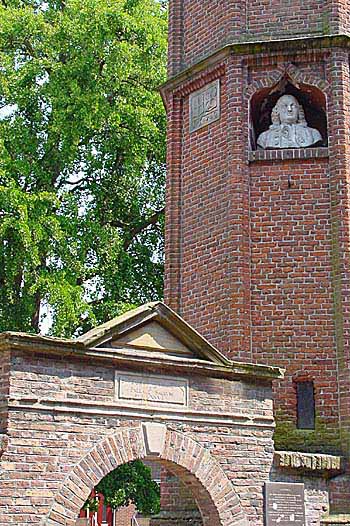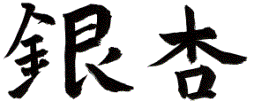|
 The
name
The
name| Kingdom
Plantae -- Plants
Subkingdom Tracheobionta -- Vascular plants Superdivision Spermatophyta -- Seed plants Division/phylum Ginkgophyta -- Ginkgo Class Ginkgoopsida Order Ginkgoales Family Ginkgoaceae -- Ginkgo family Genus Ginkgo L. |
Ginkgo
biloba:
Ginkgo : from the Chinese (later also Japanese) word Ginkyo meaning "silver apricot" (gin=silver, kyo=apricot). This term is thought to come from a romanized version for the Chinese ideograph Yin Hsing (Xing).
| Many authors have
discussed the question why Engelbert Kaempfer *
Research
in 2005 (revised 2011) by Prof. Wolfgang Michel-Zaitsu of Kyushu
University, Japan, explains a possible answer. At Deshima Kaempfer
got hold of copies of a pictorial dictionary "Kinmôzui". His linguistic
information about Ginkgo was taken from Book 18 (Fruits) in the
1668 edition of this dictionary. As Kaempfer was not able to read this
book he inserted a reference number into each frame and a second number
to mark the Chinese characters. These numbers appear again in notes he
wrote down at Deshima.
|

Ginkgo in "Kinmôzui" 1668 |

Kaempfer's handwriting in "Collectanea Japonica" |

page 811 of "Amoenitates Exoticae" |
The Chinese characters are explained in Japanese as ginkyô. Undoubtedly Kaempfer's Japanese assistant(s) who explained the characters readings to him pronounced them in the correct way. Y/g: in Kaempfer's handwriting the y differed significantly from the g. As both syllables kyo and gyo are consistently written as kio/kjo and gio/gjo by Kaempfer in his manuscripts one might expect he should have written Ginkjo or Ginkio instead of Ginkgo. Back in Lemgo there was no way to check the validity of his notes on plant names taken in Japan. Therefore the wrong writing Ginkgo was transferred from his notes into the "Amoenitates Exoticae".
*
Another possible explanation of the unusual spelling of Ginkgo is found
in an article by Nagata (Hosei University), Duval and Crane (Yale University)
in Taxon of February 2015:
Kaempfer's assistant was Genemon
Imamura Eisei, a native of Nagasaki. Analysis of both "Kinmôzui"
and "Amoenitates Exoticae" indicates that Kaempfer faithfully followed
what his interpreter pronounced, using the local dialect of medieval Nagasaki
in plant names.
biloba: two-lobed; bi from Latin "bis" meaning double, loba meaning lobes. The leaf is fanshaped with a split in the middle, hence two-lobed.
Pronunciation:
GINK-oh by-LO-bah. ![]()
Grammar:
gender masculine; plural Ginkgos or Ginkgoes.
| Silver apricot:
the
seed has the size and appearance of a small apricot when mature and a silvery
bloom on the fruit.
It is also often called Maidenhair tree, Ginkgo tree or just Ginkgo: Maidenhair tree: the leaves resemble those of the Maidenhair fern or Adiantum. |

Kaempfer mentions a resemblance between the leaf form of Adiantum monochlamys Eaton and the Ginkgo |

De Hortus, Harderwijk, the Netherlands:
Linnaeus and the Ginkgo.
This Ginkgo is said to be planted
in 1735 by Linnaeus.
More
info and photos click here ![]()
Other names are:
Ginkgo biloba L.:
The
"L" meaning Linnaeus who named it Ginkgo in his classification
in 1771 adding "biloba". E. Kaempfer first called it "Ginkgo" in 1712.
Synonyms:
Salisburia
adiantifolia. The
English botanist Smith (1797) proposed this name to honour Richard A. Salisbury,
another botanist. The internationally accepted classified name Ginkgo biloba
by Von Linné could not be changed however, so it remained a synonym.
Pterophyllus salisburiensis,
Nelson 1866.
Yin Hsing (Xing) or Silver apricot in Chinese
characters:

|
|
| Czech:
Jinan
dvoulalocný, Ginkgo biloba.
Danish: Tempeltræ Dutch: Ginkgo, Tempelboom, Waaierboom, Japanse notenboom (this last name originates from the idea that the tree came from Japan and the seeds resembled nuts, but now we know this is incorrect and the name is not in common use). English: Maidenhair tree, Ginkgo, Kew tree, Fossil tree, Temple tree. Finnish: Neidonhiuspuu (neidon = maiden's, hiuspuu = hairtree), Temppelipuu, Ginkgo. French: Noyer du Japon, Arbre aux quarante écus (referring to its high price in the 18th century), Arbre des pagodes, Arbre à noix or Ginkgo biloba. German: Ginkgobaum, Goethe Baum, Ginko, Entenfussbaum, Fächerblattbaum, Mädchenhaarbaum, Weisse Frucht, Beseeltes Ei, Tausend Taler, Bajm, Elefantenohrbaum, Goldfruchtbaum, Silberaprikose, Tempelbaum, Japanbaum, Japanischer Nussbaum, Grossvater-Enkel-Baum. Hungarian: Páfrányfenyõ. |
Icelandic:
Musteristré
(Temple tree),
Musterisviður (Temple wood).
India (Hindi): Balkuwari. Italian: Ginko. Korean: Ginkgo, Hangjamok, Gongsonsu, Apgaksu, Baekgwamok and Okgwamok. Polish:
Portuguese:
Nogueira-do-Japão.
South African: Ginkgo biloba, Maidenhair tree, Vrekboom. Spanish:Arbol sagrado, Arbol de las Pagodes, Arbol de los 40 escudos. Swedish: Ginkgo, Tempelträd. Turkish: Mabet agaci (Temple tree) Vietnamese: Cây
lá quat, cây bach quà ginkgo.
|
Tree of Forty Gold Crowns: the leaves turn a beautiful gold colour in fall and/or the Ginkgo was very expensive to buy in former times.
Wish Tree: Artist Yoko Ono (widow of Beatle John Lennon) planted a Ginkgo in Detroit. Her message: "Wish Tree for Detroit (Michigan). Whisper your wish to the bark of the tree. Yoko Ono, 2000." "I believe we can create a more positive future through wishing", Yoko stated.
Panda of the plant kingdom: Analogy with the Giant Panda's survival in China. Also called "Botanic Giant Panda".
Peace Tree: In New Bedford (Massachusetts,USA) there's a UN Peace Tree as a community symbol of hope for world peace: the Ginkgo. It was planted in 1955 by schoolchildren as a gesture of hope that all governments would join the United Nations and work toward world peace.
Asteroid Ginkgo: Asteroid 85197 (1991 TG5) is named Ginkgo after the Ginkgo biloba tree.
![]()
© Cor Kwant ![]()
Copyright information.